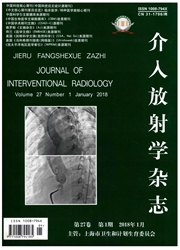

 中文摘要:
中文摘要:
目的:探讨射频消融(RFA)联合抗肿瘤药物热敏脂质体长春瑞滨(TL-VIN)治疗肿瘤的病理机制,分析联合治疗对改善实验动物长期生存率的影响。方法采用皮下种植H22肝腺癌模型的国产雄性ICR荷瘤小鼠入组本研究。分3阶段分别进行肿瘤坏死面积测量,分析治疗后肿瘤病理表现;测量瘤内药物浓度;以及对不同组治疗后生存率的比较。第1阶段,选取40只荷瘤小鼠随机接受5组不同治疗方案(每组8只)治疗后24 h取肿瘤切片,分别测量坏死面积,确认最佳热敏脂质体药物浓度;以及分析各组肿瘤治疗后的病理表现。第2阶段,选取13只荷瘤小鼠治疗后0.5 h取出肿瘤组织,测量瘤内药物浓度。第3阶段,选取32只荷瘤小鼠随机进入4组(每组8只),治疗后随访90 d绘制肿瘤生长曲线,比较各组小鼠肿瘤治疗后的生存率。结果与单纯RFA组相比,TL-VIN显著增加RFA对肝肿瘤的破坏范围(P0.05)。 TL-VIN药物浓度在10 mg/kg时可获得显著优于free-VIN的效果,为(341.8±65.4)mm2比(225.3±25.4)mm2(P〈0.01)。单纯RFA组消融区边缘坏死及变性细胞与正常肝组织交叉,界限不清;而联合治疗组消融区边缘变性细胞减少,与正常组织分界更清晰。 RFA联合治疗中,TL-VIN在肿瘤内沉积效果显著增加,浓度约为free-VIN的10倍,为(1156.5±158.3)ng/ml比(194.5±52.3)ng/ml(P =0.005)。 TL-VIN + RFA平均终点生存期最长,达(37.6±20.1)d,优于free-VIN+RFA(23.3±1.2)d及单独RFA组(23.4±5.0)d,差异具有统计学意义(P〈0.05)。结论应用新型药物载体---热敏脂质体长春瑞滨可以在加热状态下大量释放药物,提高瘤内浓度,增强与热消融协同作用,扩大坏死范围,并最终改善生存期,为RFA治疗提供了有效的辅助手段。
 英文摘要:
英文摘要:
Objective To investigate the pathologic mechanism of radiofrequency ablation ( RFA ) combined with intravenous infusion of thermosensitive liposome encapsulated vinorelbine (TL-Vin) in treating liver tumors, and to analyze the effect of combination therapy on the long-term survival rate. Methods H22 liver adenocarcinoma tissue was subcutaneously implanted into ICR mice to establish the animal models. At the first experimental period, 40 mice were randomly and equally divided into 5 groups to receive different therapeutic scheme (using different TL-Vin concentrations). Twenty-four hours after the treatment the tumor specimens were collected, the necrotic areas were measured separately, and the optimal TL-Vin concentration was determined. At the second experimental period, 13 mice were randomly selected to receive treatment. Half an hour after the treatment the tumor tissues were collected and the TL-Vin concentration within the tumor was determined. At the third experimental period, 32 mice were randomly and equally divided into 4 groups, and 90 days after treatment the tumor growth curve was drawn. The survival rate was compared between each other of the groups. Results Compared with pure RFA group, TL-Vin + RFA significantly increased tumor coagulation extent (P0.05). Tumor coagulation area in TL-Vin + RFA group was bigger than that in free-VIN + RFA group at the concentration of 10 mg/kg [(341.8 ± 65.4)mm2 vs (225.3 ± 25.4)mm2, P 〈 0.01]. In TL-Vin group the coagulation margin was clear. The mean intratumoral Vinorelbine accumulation in TL-Vin + RFA group was 10 folds of that in free-Vin group [(1 156.5 ± 158.3)ng/ml vs (194.5 ± 52.3)ng/ml, P = 0.005]. TL-Vin +RFA had better survival result than that of RFA alone (37.6 ± 20.1 days vs. 23.4 ± 5.0 days, P=0.015), as well as than that of free-Vin + RFA [(37.6 ± 20.1)days vs (23.3 ± 1.2)days, P = 0.016]. Conclusion Thermosensitive liposomal chemotherapies (Vinorelbine) can be selectively delivere
 同期刊论文项目
同期刊论文项目
 同项目期刊论文
同项目期刊论文
 期刊信息
期刊信息
